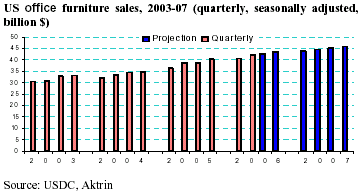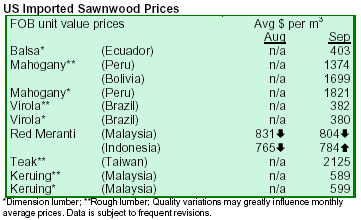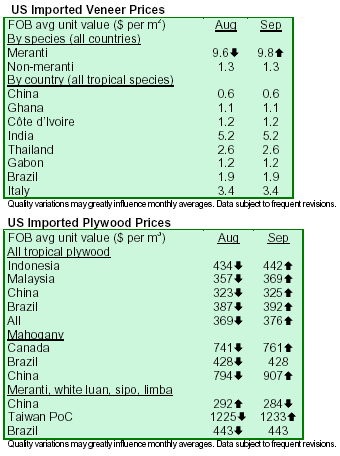|
Oregon asks for investigation of Chinese plywood
Hardwood plywood manufacturers in Oregon are crying foul when it comes to imports from China. Oregoní»s
companies account for roughly 70% of the hardwood plywood manufactured in the USA (cherry, walnut and
oak), mainly used as decorative plywood in cabinets, furniture and interior moldings.
Imports of hardwood plywood from China have spiked in recent years, rising from 442,000 m3 in 2003 to a projected
2.3 million m3 this year, according to figures collected from the US Department of Commerce. Over the same
period, imports from Indonesia, Malaysia, Vietnam and Europe have been relatively flat, according to Steve
Reister, chairman of the board of the Hardwood Plywood & Veneer Association, a trade group based in Reston,
Virginia. Two US plywood mills were shuttered in the past six months in Virginia and Oregon mills could follow, according to Mr.
Reister.
The local producersí» main complaint is that Chinese manufacturers are not held to the same environmental and
quality standards as products manufactured in the USA. Producers argue that the Chinese material does not meet
formaldehyde standards and it is being used in secondary manufacture of cabinets and furniture. US producers also
are concerned that Chinese imports are sold at artificially low prices allegedly due to subsidies from the Chinese
government, fraudulent labelling and illegally harvested logs. Senator Ron Wyden (Oregon) has written letters to
the US Department of Homeland Security, the US Trade Representative and the US Department of Commerce,
asking them to investigate alleged illegal and unfair
practices by Chinese competitors that threaten US hardwood plywood manufacturers.
IWPA responded that hardwood plywood products manufactured in China were legally imported into the
USA and received the same scrutiny for classification under the HTS as all wood products entering the country.
The US Customs and Border Protection Bureau has the
responsibility to refuse entry to any product improperly classified, according to
IWPA.
Congress renews GSP and extends CNL waivers
The US Congress renewed the Generalized System of Preferences (GSP) for two years while maintaining
Brazilí»s eligibility for wood products, IWPA informed. The renewal was part of a larger trade package.
Continuation of the competitive need limit waiver (CNL) for Indonesian plywood (HTS 4412.13.40) remains in
effect for few more years. According to the law, to be signed by the President, a waiver in effect for five or more
years can be revoked by the president beginning 1 July 2007. The waiver for plywood has been in effect since
2005, well short of the five-year time limit. However, the Office of the US Trade Representative (USTR) was
granted discretion to take away a CNL waiver, but it was unclear whether it would implement the new provision.
The 8% duty on Brazilian softwood plywood (HTS 4412.19.40) is still applicable because imports exceeded the
CNL.
US extends low tariffs for Andean nations
The US Congress extended a low-tariff regime for four Andean countries (Colombia, Peru, Ecuador and Bolivia),
giving them six months to secure permanent bilateral trade deals with the USA. The Bush administration had
proposed a year-long extension of the Andean Trade
Promotion and Drug Eradication Act (ATPDEA) which expired at the end of the month. The short ATPDEA
extension was a compromise between opposing proposals from the two US chambers.
However, the leftwing presidents of Ecuador and Bolivia had indicated that they did not intend to pursue bilateral
trade agreements with the USA. Evo Morales, the leftwing president of Bolivia, dismissed the six-month deadline
saying that other South American countries were ready to
buy from Bolivia what it sold to the USA. Rafael Correa, the Ecuadorean left-winger who won last monthí»s
presidential elections, said the ATPDEA was not charity but í░compensation for the war on drugsí▒ the countries were fighting on behalf of the USA.
US consumer spending on office furniture
This second article analyzes the US office furniture sector. Growth of pre-tax corporate profits in 2005 stood at 12.5%
and is predicted to be a healthy 19-20% this year. However, with the expected slowdown of the US economy, corporate profit growth in 2007 would decline to about 5% according to Aktrin. This prediction is based
on the assumption that both interest rates and the value of the dollar will remain low. Business investments
progressed at a rate of 6.8% in 2005 and growth is likely to reach 7.5% this year and decline to 5.6% in 2007.
Investment in machines and equipment (including office furniture) did better, advancing 8.9% in 2005 and an
expected 7.2% this year. This investment will probably fall to 5-6% in 2007.

Spurred by corporate profitability, the job market improved in 2004 and 2005. Employment growth
advanced 1.8% in 2005 (up from 1.1% in 2004). However, Aktrin predicts a growth of only 1.2% in 2007.
Expenditure on non-residential construction (including office space) was frail up to 2005, when it grew 1.1%.
However, non-residential construction will probably grow 8.1% this year and 4.6% in 2007.
Following several years of decline, positive growth of business outlays for office furniture resumed again in
2003. However, progress remained very shallow and did not reflect the overall pick-up in business investments. A
noticeable improvement was witnessed last year when the
office furniture market advanced by 14%, reaching $38.5 billion (at end-user prices and including recycled
furniture), thereby surpassing the previous peak value in 2000. Growth this year is estimated at approximately 10%,
bringing the market size to a record value in excess of $40
billion. With lower corporate profits, slower employment growth and much of the pent-up demand for office
furniture being satisfied, Aktrin predicts a lesser growth rate of about 6.2% for the office furniture market in 2007.


|